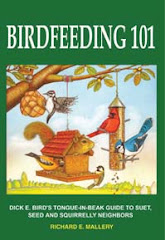
CWD rule: If it attracts deer, remove it
by Howard Meyerson
You might wonder just what sick deer and Chickadees have in common. The answer isn't obvious unless you live in the country where deer gather under bird feeders.
Both will feed on sunflower seeds. That presents a dilemma for some people who like to feed birds.
Both will feed on sunflower seeds. That presents a dilemma for some people who like to feed birds.
Michigan Department of Natural Resources director Becky Humphries signed an emergency order last week calling for a ban on deer and elk baiting and feeding in the Lower Peninsula.
That goes for bird feeding, too -- if deer are drawn to the scratched seeds on the ground. The ban was put in place to slow any potential for spread of chronic wasting disease, which was found in one captive-bred deer on a Kent County deer farm.
So far, no wild, free-ranging deer are known to have it. State officials are hopeful that it is a one-deer case.
But they also know baiting and animal feeding can accelerate its spread, should it somehow be found outside the enclosure where the sick deer was euthanized.
Deer that gather to feed, breathe on food and defecate where they are eating. Other deer come in contact with that food.
"People are calling in about what they can put in bird feeders," said Sara Schaefer, the DNR's southwest Michigan wildlife supervisor. "We are recommending that they use bird seed or suet that does not attract deer.
"Finch food is not so much an issue as shelled corn or sunflower seeds, which are popular with deer. They will come in and clean up around the feeders."
In all cases, it will be up to the conservation officer to determine whether a landowner is complying with the ban and whether the circumstances warrant action.
The line is reasonably clear. If it attracts deer and they feed there, it's a problem.
In the heart of Grand Rapids, where I live and keep five bird feeders, I don't see any deer. No elk. No moose. I know as I say this, I will wake up tomorrow and find a huge buck staring in my living room window.
I do get an occasional skunk, possum, rabbit and stray cat in my yard. But they would rather rifle trash bags than raid feeder droppings.
But friends in the suburbs speak regularly of seeing deer. Feeders in their backyards could well be a problem.
"There are lots of urban deer, so the baiting ban applies to everyone," said Schaefer.
Disease poses no risk to humansState officials say there is no risk to humans from the disease.
"We are getting calls from people saying 'I know its banned, but can we do this or that,' trying to get around the rule," Schaefer said.
There are even those who call and ask if a Lower Peninsula "ban on baiting" means they can't bait.
Hmmm. Ya gotta wonder.
The ban that went into place last week prohibits putting out salt blocks, minerals, grains, seeds, hay, vegetables and other food that will attract deer. It allows for hunting food plots or over food scattered naturally as part of normal agricultural practices.
The intent is not to stop Mrs. Smith from feeding Chickadees, Schaefer said, but to stop her from doing anything that will attract deer in to feed.
Bear baiting also is limited to foods that deer don't eat. Donut piles are still OK. Jelly donuts, French crullers, even Oreos. Deer, I'm told, don't have a sweet tooth.
Meat and fish products also remain ok bear bait.
I guess deer don't like Sushi either.






